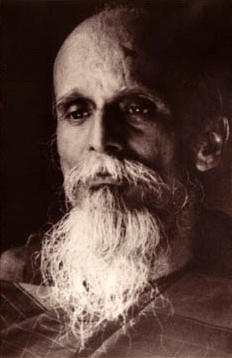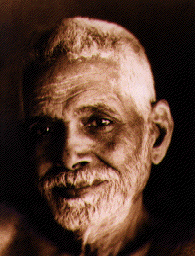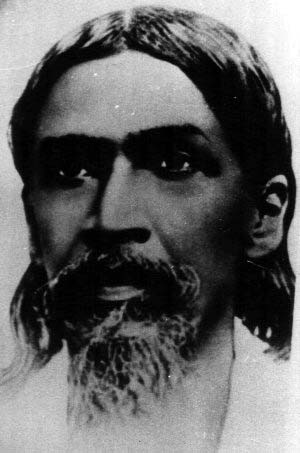Vasistha Kavyakantha Ganapati Muni
A Colossus of Tapas and Learning

Vasistha Kavyakantha Ganapati Muni belongs to the race of giants who crowded in the narrow corridors of the first four decades of the 20th Century.
Ganapati Muni was born in Kalavarayai, near Bobbili in Andhra Pradesh, on November 17, 1878. His parents, Narasimha Sastri and Narasamamba, had three sons, the Muni being the second. His was a family of Sri Vidya initiates.
A year before his birth his mother Narasamamba had gone to the famous temple dedicated to the Sun God at Arasavalli, in Andhra Pradesh. It was a holy day (Ratha Saptami) to offer worship to the Sun God. She stayed overnight in the temple, after worshipping the Lord in due manner. In the early morning she had a dream in which a woman of supernatural beauty emerged from the corridors of the temple, approached her with a fine shining pot, put it in her hand and vanished. To her utter astonishment the fine pitcher assumed the form of a male child the moment it came into contact with her. After her return home she became pregnant.
The father, Narasimha Sastri, also had a unique experience. He had gone to Banaras (Varanasi or Kashi) in November 1878. When he was in the temple praying in the presence of the deity Ganapati, he had the vision of a little child emanating from the deity and entering into him. At the time when Narasimha Sastri was witnessing this vision in Banaras, his wife Narasamamba gave birth to a male child in her parental home. This child was born under these auspicious indications given to both parents. The father appropriately named this son Ganapati, rooted in the conviction that the child was an emanation of the Lord Maha Ganapati Himself.
It appears that Ganapati was conscious of his divinity. He later wrote in 'Uma Sahasram' and other works that he was born as an amsa, a portion, of the God Ganapati. He further expressed his conviction of the identity between him and God Ganapati — the guiding spirit of his corporeal existence — in the "Glory of Ganapati".
Ganapati was educated entirely at home. His father, like his ancestors, was well versed and an expert in Mantra Sastra, Astrology and Ayurveda. The young Ganapati easily absorbed all these subjects. Even in his tenth year he was able to prepare the Almanac.
While still a boy, he finished studying the classical poems and then devoted himself to the study of grammar and poetics. At the same time he delved deep into the writings of Vyasa and Valmiki. He repeatedly read and reread the Mahabharata. His horizon widened and his intellect blossomed with an ever-deepening perception. Like in ancient times, Ganapati desired to acquire immense strength and power through the practice of austerities and mantra japa.
Though married at an early age, which was the custom of the times, Ganapati, when hardly 18 years old, set out and wandered from one sacred place to another, residing in places like Bhuvaneshwar, where he performed his tapas. In a dream while in Bhuvaneshwar, Ganapati saw a woman putting honey in his mouth and onto his tongue and then vanishing. Later, the Muni himself narrated this to his disciples and said that only after this incident did he gain complete mastery over poetry.
When Ganapati was staying in Kashi he came to know that there would be a great assembly of Sanskrit scholars in the famous city of Navadwipa in Bengal. On the advice of his friends he got a letter of introduction and started for Navadwipa. There he passed the difficult tests in extempore Sanskrit prose and poetry with an effortless ease that stunned his examiners. Unanimously, they conferred the title 'Kavyakantha' (one who has poetry in his throat) on him forthwith. He was then 22 years old.
Ganapati returned to South India in his 25th year. From Kanchipuram he came to Arunachala (Tiruvannamalai) in 1903 to perform tapas. At that time he visited Sri Ramana Maharshi — then known as Brahmanaswami — on the hill twice before he accepted a teaching post in Vellore in 1904. By his organizing ability and magnetic personality he gathered a group of students who, by the power of mantra japa, set out to generate spiritual energy to cure the ills of the nation. In fact, it was his strong conviction, like that of Swami Vivekananda's, that national welfare should be placed above individual salvation. He soon resigned his job at Vellore and returned to Arunachala in 1907. It was at this stage in his life that he sought and gained the grace of Brahmanaswami.

Though he was already an intellectual and spiritual giant, with many achievements to his credit, and a host of followers as well, Ganapati felt distressed that his life purpose was not yet achieved. He suddenly remembered Brahmanaswami, climbed the hill to his abode and prayed to him for upadesa. The meeting was of profound consequence, not only for Kavyakantha, but also for the world at large.
The Muni approached the Virupaksha Cave where Brahmanaswami lived on the 18th of November 1907. Prostrating before the young Sage, he pleaded with a trembling voice: "All that has to be read I have read. Even Vedanta Sastra I have fully understood. I have performed japa to my heart's content, yet I have not up to this time understood what tapas is. Hence, have I sought refuge at thy feet. Pray enlighten me about the nature of tapas."
For fifteen minutes Sri Ramana Maharshi silently gazed at the Muni. He then spoke: "If one watches where the notion of 'I' springs, the mind will be absorbed into that. That is tapas. If a mantra is repeated and attention is directed to the source where the mantra sound is produced, the mind will be absorbed into that. That is tapas." Upon hearing these words of the Sage, the scholar-poet was filled with joy and announced that this upadesa was entirely original and that Brahmanaswami was a Maharshi and should be so called thereafter. He then gave the name of Bhagavan Sri Ramana Maharshi to Brahmanaswami, whose original name had been Venkataraman.
Ganapati Muni wrote his great devotional epic hymn, "Uma Sahasram," One Thousand Verses on Uma, after accepting Sri Maharshi as his Guru on November 18, 1907. This work was the magnum opus of the seer-poet. He never wrote for name or fame, but composed poetry as a form of tapas, inspired by his spiritual exultations. He composed "Uma Sahasram" in gratitude to the great Goddess Uma, for granting him the Maharshi as his Master.
Vasistha Ganapati Muni was a valiant soldier in the cause of Truth and Divinity. For communing with the Divine, the Muni was well endowed, gifted with marvelous powers of mind, intellect and spirit. To this day, the greatest scholars of modern times are astounded by his versatility and genius. With absolutely no formal schooling, he could immediately grasp the most intricate problems of the day and devise solutions. His immense scholarship of Hindu Scriptures, coupled with a faultless memory and Divine intuition shone on his face and flowed out through his writings and oratory. He belonged to the era of Rig Vedic seers who were gods among men, playing in the world their role of leadership of both temporal and spiritual matters.
The Vedic seers were by no means removed from the affairs of the world. In fact, these seers made themselves the vehicle through which the Divine forces worked for the welfare of humanity. To become one such perfect instrument in the hands of Maha Shakti was the goal towards which Ganapati worked and dedicated his entire life of penance.
Though the Muni was a giant personality, he remained humble. Two incidents in his Divine life will illustrate this: The Muni and his beloved disciple Daivarata did tapas in Padaivedu, near Vellore, in the year 1917. As a result of these tapas certain mantras were revealed to his disciple Daivarata. The Guru of the disciple, our Ganapati Muni, acted as the scribe and noted down the mantras as they issued forth from his inspired disciple. Later, the Muni even wrote a commentary on the mantras, just as Adi Sankara did for the verses of his disciple Hastamalaka[1].
The Muni was verily a fountain of love and affection for his pupils and followers, far and near. This did not deter the Guru and sishya from having a difference of opinion at times. Nevertheless, Ganapati's broadmindedness and love never wavered on account of these differences, thus revealing his humble respect and genuine love for all. He even readily blessed one of his dearest disciples, Kapali Sastri, when he wished to become a disciple of Sri Aurobindo
 .
.
I would like to make the readers aware of the fact that the poet-seer, Kavyakantha Ganapati Muni, met Sri Aurobindo on August 15, 1928. He stayed at the Ashram for about a fortnight. During his stay the Muni meditated alone with the Mother a few times. At the instance of Sri Kapali and Sri S.Doraiswamy Iyer the Muni translated some portion of Sri Aurobindo's "Mother" into Sanskrit verses, with some notes. Seeing the Muni's translation, Sri Aurobindo generously declared that the translation far excelled the original.
Ganapati Muni was a great tapasvi whose one aim in life was the restoration of Mother India to her ancient majesty. Unlike others who aimed at liberation for themselves, this inspired soul believed that he must obtain the grace of God, not only for himself, but also for the nation, and through it for the betterment of the world. Towards that consummation he had done penance from his early youth and very rigorously during the last years of his life.
Sri Ganapati passed away at Kharagpur, in West Bengal, on July 25, 1936, when he was 58 years old. The Muni was the only person in our times known to have experienced Kapalabheda, which occurred in 1922 at the Mango Cave on Arunachala. As the result of intense tapas, the subtle knot in his head was cut and his cranium split.
Sri Kavyakantha Ganapati Muni's writings, particularly on the Rig-Veda and the Tattwa Sastra, will most certainly be a guiding spirit and lamp for centuries to come.
![]()
Shri K. Natesan's Personal Memoirs about Kavyakantha Sri Ganapati Muni
My contact with Ganapati Muni started when I was studying in Tiruvannamalai, during the 1920s. His son, Sri Mahadeva Sastri, was my Sanskrit teacher at my High School. On many subjects, the Muni addressed our school Sanskrit Association. I had the good fortune of listening to his valuable talks. Later the Muni initiated me into certain mantras. Once, when I requested him to advise me on how to get a good knowledge of Sanskrit, he immediately instructed me to go on reading and writing his works as often as possible. I took this to heart and have been reciting, writing, compiling and collecting his works throughout my long life. I have gone to Sirsi a number of times to collect these works from Sri D. S. Viswamitra, who was one of the favorite disciples of the Muni. During his physical presence, Bhagavan Ramana blessed and encouraged me in this sacred task, and even now, long after his Mahasamadhi, I still feel his blessings and guidance.
I have the greatest good fortune and pleasure, and feel wonderfully blessed by the Muni and Bhagavan Maharshi to be used as the instrument to offer these inspired treasures of the seer-poet, Vasistha Ganapati Muni, to the world.
![]()
Manuscript Courtesy: Dennis Hartel, Arunachala Ashrama